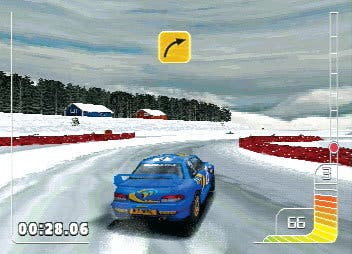Series Retrospective: Colin McRae Rally
Definitely flat out.
Powersliding, while a glorious, evocative word for petrolheads, proved an irritatingly elusive dynamic for driving game developers of the 1970s, eighties and very early nineties. Indeed, it was only the remarkable acceleration the genre benefited from as a result of videogaming's transition to 3D (coupled with the renewed processing power of enhanced hardware) that finally enabled the recreation of drifting a box of polygons sideways through a corner in a manner that felt satisfyingly convincing. Up to then, even the most fervent member of the Sprite Generation knew deep down that adding smoke and screeching effects à la OutRun just didn't cut it. If you're going to give the illusion of powersliding, you need to do it in three dimensions. Namco's absurdly popular Ridge Racer was an early front-runner in this regard and soon found a rapidly growing number of efforts from other publishers in its slipstream.
Forgive the historical introduction, but it is crucial in understanding why it would be another couple of years before developers felt confident enough to take driving games off-road. Because unlike circuit racing, powersliding is a fundamental component of rallying - get that wrong and it doesn't really matter how good the game's other elements are.
Thankfully, one particular game got it very right.

Many will remember 1995's SEGA Rally Championship and its subsequent Saturn conversion with great affection. What many often forget is that while we think of rally titles as being well represented in contemporary gaming, the subgenre did slide off the scene soon after SEGA's landmark outing. True, slam your memory into reverse and you will find contenders - Milestone's Screamer Rally or V-Rally from Eden Studios come to mind - it's just that they failed to have the impact that SEGA's defining take on rallying deservedly enjoyed in both its arcade and home form.
Codemasters was one of those affected. Inspired by SEGA AM5's work and sensing another gap in the market (after so brilliantly exploiting the British touring car licence in TOCA Touring Car Championship), the publisher turned its attention to rallying. The Colin McRae series was born.
In retrospect, the choice of Colin McRae on which to base a franchise may seem obvious, but in the second half of the 1990s the WRC was all about Tommi Mäkinen - by the time the first CMR rolled out of Codemasters' development pits, the Finn was eyeing up his third successive world title (he'd go on to add another one before leaving most of the podium appearances to Grönholm, Burns and co).

Whether the act of Europress obtaining the Mäkinen licence (a mediocre game ensued, alas) influenced matters or not, the reality is that as majestic as the real-life Mäkinen proved at the wheel of his Mitsubishi Lancer Evo, there was arguably no driver/car pairing at the time that could match 1995 champion McRae and the Subaru Impreza 555. Even when sat idling, the distinctive Prodrive-prepared Impreza looked as though it was doing 100mph and in the hands of one of the most flamboyant, brave drivers of his generation - "If in doubt, flat out," goes the famous McRae saying - the combination would come to epitomise everything that made the late-nineties World Championship Rally series one of the most thrilling forms of motorsport in the world.
The McRae/Codemasters partnership turned out equally successful. Sequels came thick and (at times a little too) fast, but the quality and confidence of the driving model so evident in the franchise's first outing never failed to evolve. Ably supported by McRae's genuine involvement and Codemasters' growing technical competence, it resulted in consistent world-class rally driving productions. When McRae ended up without a WRC drive in 2004 it was hardly surprising to see the association remain firmly in place, with the games wisely adapting themselves to the Scot's more widespread motorsport activities.
Just as there can't be many who questioned Codemasters' decision to continue with the franchise following that tragic helicopter crash. So as we approach the second anniversary of McRae's death, and the release of the second DiRT title, it seems a fitting time to power down the gravel track that has led the genre-leading series to this point. Strapped in? Enjoy the ride.








